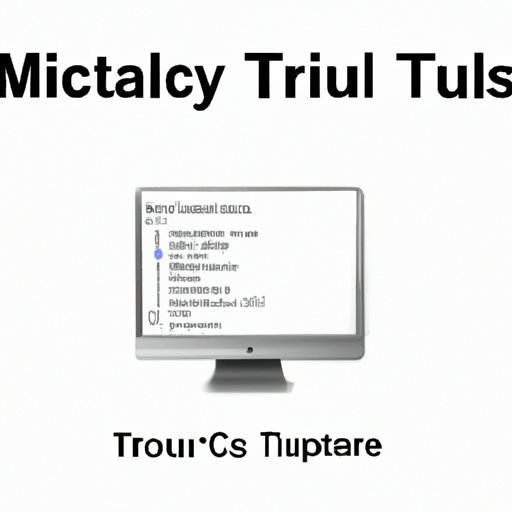How to Take a Screenshot on a Mac: A Step-by-Step Guide
Where would we be without the ability to capture a screenshot? Whether you’re a blogger, designer, or simply want to show someone what you’re working on, knowing how to take a screenshot on your Mac is an essential skill that can save you time and make your life a whole lot easier. In this article, we’ll explore different methods for taking a screenshot on a Mac, including built-in tools and third-party software. We’ll also provide tips and best practices for optimizing and sharing your screenshots. Let’s get started!
A Step-by-Step Guide
The easiest way to take a screenshot on a Mac is to use keyboard shortcuts. There are three main shortcuts you can use: Command + Shift + 3, Command + Shift + 4, and Command + Shift + 5.
Taking a Screenshot of the Entire Screen
If you want to capture a screenshot of your entire screen, simply press Command + Shift + 3. This will take a picture of everything currently displayed on your screen and save it to your desktop.
Taking a Screenshot of a Selected Window
If you want to capture a screenshot of a specific window, press Command + Shift + 4 and then press the space bar. Your cursor will turn into a camera icon. Click on the window you want to capture, and the screenshot will be saved to your desktop.
Taking a Screenshot of a Portion of the Screen
If you want to capture a specific portion of your screen, press Command + Shift + 4. Your cursor will turn into crosshairs. Click and drag over the area you want to capture. Release the mouse button to take the screenshot.
Tips for Using Keyboard Shortcuts Effectively
To ensure that your screenshots are captured accurately, make sure you don’t have any windows overlapping or hiding the content you want to capture. It’s also a good idea to use the keyboard shortcuts on a clean desktop, without any other open windows or running apps.
Using Built-In Tools
While keyboard shortcuts are the easiest way to take a screenshot on a Mac, there are also built-in tools you can use.
Keyboard Shortcut Keys
If you’re using a Mac running macOS Mojave or later, there’s a new set of keyboard shortcuts you can use. Press Command + Shift + 5 to bring up the Screenshot toolbar. From here, you can choose to capture the entire screen, a selected window, or a custom portion of the screen. You can also choose to record a video of your screen or take a screenshot of the Touch Bar.
Screenshot App
If you prefer using a graphical user interface to take screenshots, you can use the Screenshot app. To access the app, press Command + Shift + 5. The Screenshot app provides all the same features as the keyboard shortcuts, but with a more user-friendly interface. You can also choose to delay the screenshot, show and hide the cursor, and show the on-screen controls.
Using Third-Party Software
While the built-in tools for taking screenshots on a Mac are powerful, they may not offer all the features you need. For more advanced options, you can use third-party software.
Why Use Third-Party Software?
Third-party software can offer features like annotation, highlighting, and even automated screenshots. For example, Skitch and Snagit are both popular third-party options that offer advanced features for annotating and editing screenshots.
Comparison
When deciding whether to use the built-in tools or third-party software, it’s important to consider what features are most important to you. While third-party software may offer more advanced options, the built-in tools are usually more than adequate for basic screenshot needs.
Optimizing Screenshots
Once you’ve taken a screenshot, you may want to optimize it to look its best.
Adjusting Image Quality and Size
If you’re planning on using your screenshot for online purposes, like social media or a blog, you may want to optimize the size and quality of the image. Smaller file sizes will load faster, while higher quality images will look crisper and more professional. There are many free tools available for adjusting image quality and size, like Adobe Photoshop or GIMP.
Formatting for Different Applications
It’s also important to format your screenshot to fit the requirements of different applications. For example, if you’re submitting a screenshot with a document, you may want to format it as a JPEG or PNG. Conversely, if you’re uploading to a social media platform, like Instagram, you may want to format it as a square or vertical image.
Sharing Screenshots
Once you’ve taken and optimized your screenshot, you may want to share it with others.
Emailing, Messaging, or Uploading to Sharing Services
To share your screenshot, you can email it as an attachment, send it via messaging app, or upload it to a sharing service like Dropbox or Imgur. When sharing, make sure the recipient can properly view the image – if the file size is too large, they may not be able to download it.
Tips for Ensuring Your Screenshot is Shareable
Before sharing your screenshot, double-check that it properly captures the content you want to share and that it looks good at the size you’re sharing it. You may need to adjust the image quality or size before sharing it to ensure that it’s optimized for the platform you’re using.
Conclusion
Taking a screenshot on a Mac is a simple and useful skill that can save you time and make your life easier. Whether you use the built-in tools or opt for third-party software, knowing how to take and optimize a screenshot can be helpful in many different situations.
